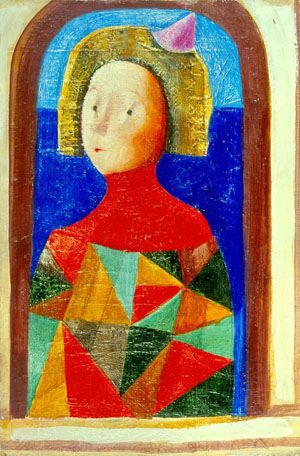“Portraits” of resistance
“Odesa non-conformism” distinguished itself as non-political and “purely artistic” from other forms of underground art in Soviet cities
Thirty years have passed since Liudmyla Yastreb died, and forty-five since her creative path began. The artistic discoveries of this talented painting and graphic art master from Odesa, an amazingly whole-hearted personality, have already become an integral part of modern Ukrainian art. Her works are “portraits” of the unique creative situation in which Yastreb found herself — the milieu of Odesa non-conformists. That is where she formed a new world outlook, a basically informal attitude to art, and began to seek an adequate, expressive artistic language. It was formed through a complicated and deep inner process of bringing forth her artistic self via the already existing traditions of icon painting, Renaissance art, baroque, and European modernism.
The starting point of “Odesa non-conformism” was the cult event of 1967, when young artists Valentyn Khrushch and Stanislav Sychov organized a “fence” exhibit of their works, calling it “Sychyk and Khrushchyk.” They presented it on the fence of the Odesa Opera Theater, and it was an immense success. The artists became the city’s heroes in one day. This was how the movement of the Soviet underground art began. The then artists, who represented “foreign” Western culture, found their way to the audience via the so-called “apartment events” or “apartment exhibits.” In the center of the movement of Odesa non-conformism were Khrushch, Sychov, Yastreb, Anufriiev, and Strelnykov. It was Yastreb who came up with the name “Non-Conformists.” The principal difference between Moscow’s formal art and “Odesa non-conformism” was that the latter was non-political and “purely artistic.” It also sought new aesthetic forms of self-expression. Now most of those who participated in the movement have either emigrated or died, though Oleksandr Roitburd follows the traditions of avant-garde non-conformism in his creative work.
Nowadays 30 years is a hard test for pictorial arts, laying bear the brevity of life. Aren’t Yastreb’s images somewhat outdated, a thing of the past, in spite of the recognition of professionals and fellow artists? We now live in a different world, created by different visual “optics,” therefore, naturally, it hardly correlates with the artist’s creations. Yet the value of Yastreb’s imaginative world continues to grow. More than ever before Ukrainians (and not only they) have found themselves in the whirl of insincerity and indifference to each other. When you look at Yastreb’s works, you feel from the first minute that they are something authentic, true, and genuine.
Yastreb’s language is not a flashy verbosity, it is revealed through colors, lines, and composition. Yastreb creates her images through the simplest means and cuts off unnecessary things, leaving as much space as possible for light in her works. This is the way the artist creates a model of a natural woman which turns everything around her into harmony, above all owing to her inner light. Maybe because this artist was just like that.
COMMENTARIES
Olha PETROVA, art expert, Ph.D. (philosophy)
“You could feel the spirit of freedom in Odesa, you breathed freer and deeper there than in other Soviet cities, especially big ones. The sea, the sun, and ships, smiling passers-by… And art fixed all these things like a chronograph. It is a mistaken opinion that Odesa was an ‘oasis’ of Soviet officialese, there was less of it than anywhere else. Yastreb was a very influential personality in the circle of non-conformists and in the artistic circles of that time, on the whole. Already then it was absolutely clear that she was a deep and extraordinary artist. Abstract canvases of this Odesite are perceived as free and natural, yet full of deep content and strength. Colors may dominate in these and figurative works, but as they are framed in a ‘calm composition,’ almost always you can feel their harmony and inner balance. In the artist’s work earth and heaven, flesh and spirit are balanced: you can’t say that any of these prevails, neither do sensual or transcendental things. Yastreb’s friends and acquaintances noted that suffering from an incurable disease for seven years, being totally aware of it, she continued to paint her light works, as if she was not afraid of physical death and looked calmly into the future. This is amazing. In my opinion, only a person of a very strong will is capable of this.”
Iryna VOZIIANOVA, supervisor of Liudmyla Yastreb’s exhibit in Kyiv:
“The authenticity and genuineness of Yastreb’s art is a feeling of soul’s purity, which uncompromisingly reveals itself before you, and purity of language in which she sings her melody. The pure sound of her painting consists in the immense knowledge of color, line, and texture, which she acquired on her own, though in the underground milieu. Her colors are often light, bright, even ‘joyful’ and ‘cheerful,’ though there is nothing wild or loud about them. They are not self-sufficient as they always subdue to a thoroughly thought-out and lived-through plan.”
Newspaper output №:
№23, (2011)Section
Time Out





